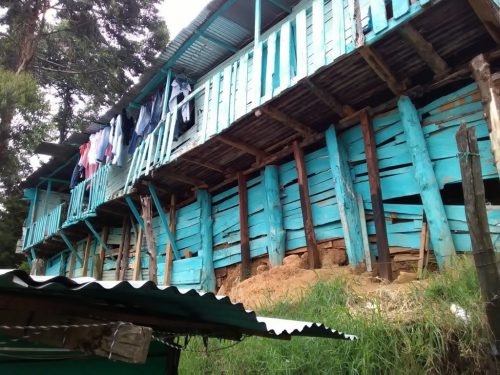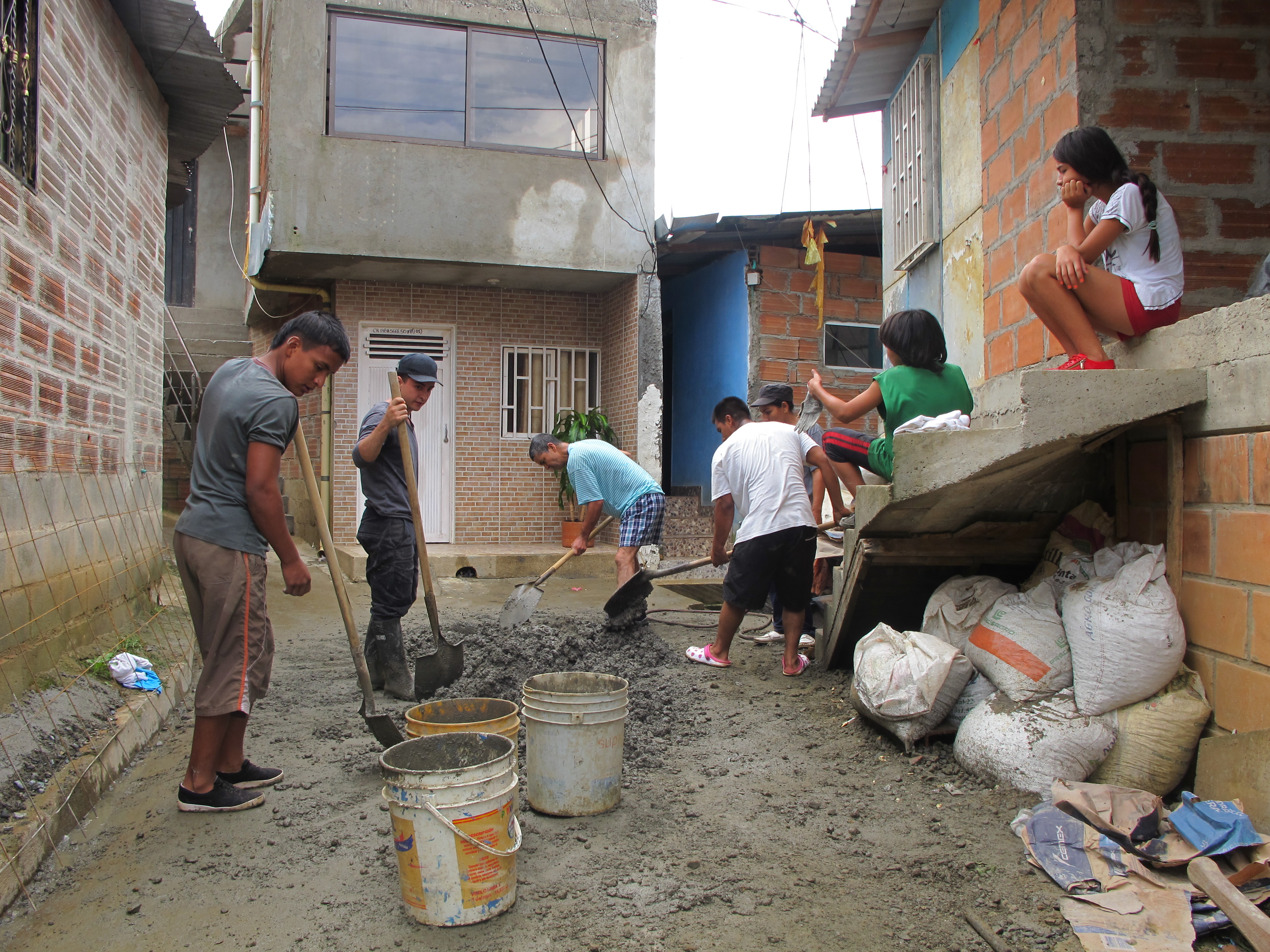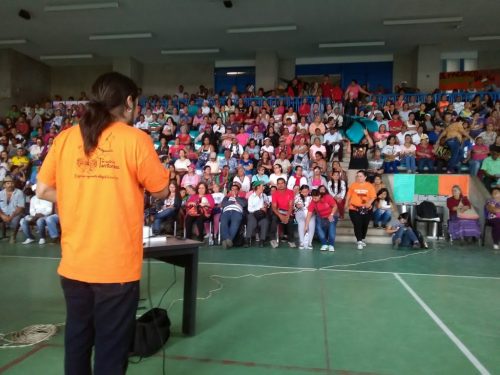Every year landslides cause loss of life and damage to property in Colombia. People in informal urban settlements are particularly exposed. With support from local government, researchers, and others, they can understand – and work to mitigate – such risks.

Pinares de Oriente is a small community of 180 households built on steep slopes, hundreds of metres above the city of Medellín. Most of the population was internally displaced by conflict elsewhere in the country, fleeing from threats to their lives and livelihoods.
The first priorities for new arrivals in Medellín are to get a roof over their (and their children’s) heads, and to feed their family. Many individuals obtain a plot of land on which to build a small shack and eventually a house, and get by with manual jobs such as cleaning rooms in hotels in the city. Despite meagre pay and an expensive and long daily commute to work via local buses that travel down hair-raising slopes, most are happy to have got their family to apparent safety.
However, an underlying danger exists in Pinares de Oriente, where many are unaware of the tragedy that struck the nearby neighbourhood of Villatina, 30 years earlier. On September 27, 1987, approximately 500 people died in a landslide. The predominantly young population of Medellín has no community memory of the event. Most residents are also unaware that the soil on which their houses stand is exactly the same type as that which engulfed Villatina with such devastating consequences. After large storms, areas with this type of soil tend to have small landslides, in particular across the north-east sector of the city.
Landslides are a threat throughout many Latin American cities. The poor are the hardest hit, as they tend to live in informal settlements that are perched on steep hillsides on unstable ground. Wealthier people tend to live on safer ground, either closer to the city centre or in high-income suburbs that are less exposed. This pattern is observed in cities around the world: perhaps other threats loom, such as water shortages in Lagos and the potential for flooding in sinking informal neighbourhoods in Jakarta.
But partnerships of academics and residents can help local people living with these risks. In Medellín, one such project is “Resilience or resistance?”, with the ambitious goal of identifying politically and practically viable approaches to landslide risk-reducing strategies in the city and its informal settlements. Negotiation and cooperation between communities and local government are key to its success. The safety of people who are building their lives and their homes on the hillsides around Medellín depends on such spaces for dialogue and negotiation.

How communities can manage landslide risk
The threat of landslides affects an estimated 44,600 households in informal settlements in Medellín. As some community leaders in the area became increasingly aware of the threat, they pleaded with local authorities to officially recognise their illegal and irregular settlements and to turn them into dignified and well-serviced neighbourhoods. The pleas then broadened, with a demand to make the communities safe through investments in mitigating the risk of landslides.
An increasingly literate and well-connected community leadership developed the notion of a “dialogue of knowledges”, bringing together knowledge from academic researchers and local residents. The idea was to foster a collaboration with academia in the quest to lobby local government to improve living conditions.
The participatory-action research project that resulted, officially called “Resilience or resistance? Negotiated mitigation of landslide risks in informal settlements in Medellin”, was funded by the UK’s Global Challenges Research Fund and administered by the Natural Environment Research Council. The project was put together with the help of a highly connected community leader, and it partnered the community with a multidisciplinary team of academics from the Universidad Nacional de Colombia Sede Medellín, Heriot-Watt University, and the University of Edinburgh.
“Resilience or resistance?” was set up to show how landslide risk-reducing strategies could be implemented in informal settlements, from the community and state perspectives. The project’s aim was to understand the barriers to such strategies, and to identify politically and practically viable approaches to them, within a wider and more complex context of social and physical risk.
Despite having precious little available time after long working hours, commute, and childcare, many women volunteered to take part in the project. They got a sense from community leaders that by doing so, they might receive home improvements that would help stop heavy tropical rain leaking into their homes. Reducing dampness and improving health conditions in their homes would make life more comfortable – and also save valuable time spent dealing with the leaks.
The community of Pinares de Oriente has increased its awareness of both risk and its own capacity to act.
The project started with a couple of meetings between residents, community leaders, and the academics in the community hall. In the community meetings, the residents initially denied they were exposed to any major landslide hazard, for fear of eviction. They instead wanted to focus on the need for proper services in the neighbourhood, such as clean water, and on how to get legal titles to the land on which they lived. After some time, however, particularly after the academic team conducted interviews with individual residents, the people began to trust that the researchers weren’t going to bring local authorities in to evict them because of the landslide risks. The older and more established residents were the first to open up and start admitting and discussing the risks.
Some participants were surprised at how big the risks were. Many volunteered to join in a landslide hazard monitoring pilot scheme as part of the research project, which started off with a mapping exercise where residents worked with geologists from the academic team. The goal was to identify places where water was not properly controlled in the neighbourhood, and where land was already crumbling or slipping. They then looked for critical points to monitor in these places.
Participants with a critical point near to their home became “community-based researchers”, using their smartphones to take photos regularly and send them to a messaging group that the academics set up. Some of the more enthusiastic neighbours even filmed and sent short videos. While taking the pictures, residents began to realise how much harm the heavy rains could cause, and just how exposed their homes were.
The academic team, with the residents’ input, identified key areas in the neighbourhood where low-cost fixes could mitigate the risk of landslides. The same has been done elsewhere in Latin America and the Caribbean. From the exercise, the team quickly understood that what initially appeared to be only a problem of soils also depended on how water flowed through the neighbourhood. During conversations between residents and technical experts, the residents began to realise that the main issue was controlling the flow of rainwater.

Redirecting the flood
The project set out to provide materials and technical guidance to channel water and interlink drainage pipes, ditches, and more. The spaces and lanes between people’s homes were targeted, linking these to public places such as main streets and squares where it was clear that responsibility for drainage lay with the city authorities. Residents put in their labour, and over a few weekends rainwater management improved dramatically across the neighbourhood.
The research team debated over whether project funds should be used to provide gutters and downpipes for individual homes. The researchers’ concern was that it could create tensions within the community if some households benefited directly and others didn’t. The team decided to provide individual support only in critical cases, where the lack of appropriate drainage in a house would also affect others. However, the project ultimately raised people’s awareness, and individuals who could afford it started to install gutters and downpipes, by setting aside some of their weekly income and getting help from local builders.
As residents became more aware of the landslide hazard and understood what actions they could take as individuals and as a community, they also saw the limitations to what they could achieve on their own. Their work highlighted the importance of short-term mitigation actions to confront immediate threats, as well as the importance of thinking about the long term.
For example, one opportunity arose to combine short-term water management to reduce landslide risk with longer-term water storage to irrigate the community orchards and market gardens. The orchards and gardens had been established a few years earlier to provide food security and contain unplanned urban growth, but after initial enthusiasm the community’s dedication to looking after them had waned.
New settlers had continued to encroach on the land around them as the orchards were created with no long-term management plan, and the local authority had only limited control over who settled on the land. The local authority owned a water tank near the orchards but it was not available to the community to provide regular watering. The “Resilience or Resistance?” project identified the tank as a possible collection point for rainfall and surface water run-off. Once captured to reduce landslide risk, the water could also be a source of irrigation for the orchards.
Last year, a student project from the Universidad Politècnica de Catalunya looked at how to breathe new life into the orchards and create local businesses based on tourism. The project generated proposals that ignited a new interest among the community. Among other things, the students suggested making a longer-term plan alongside tackling the immediate risks. Such longer-term thinking will require involving stakeholders with broader responsibilities, primarily the municipal government.

Challenges and breakthroughs
As the headline demand in a district-wide public meeting last August, landslides finally became part of the conversation that might have knock-on effects for the whole community.
One Saturday morning, a 650-strong audience of community residents met with the most local level of the public administration and the city-level authorities. The atmosphere was confrontational as the community-based monitoring and mitigation was presented to the city: community leaders were dissatisfied with the responses they received from the city authority representatives. The community leaders requested approval of the technical studies of landslide risk that would provide a legal basis for municipal investment in major mitigation works and some degree of rehousing, but were told the approval process was still ongoing.
The “Resilience or resistance?” project found an alternative way of breaking through this stand-off. A couple of months after the district-wide meeting, the project team and community volunteers in Pinares de Oriente invited a delegation of relevant local government agencies to visit the neighbourhood and listen to an explanation of the monitoring and mitigation work they had undertaken.
In a less confrontational atmosphere, this communication between community and local government led to a mutual understanding that risk mitigation action required at an immediate stage may be different from longer-term plans for the neighbourhood.
Continuing dialogue
The community of Pinares de Oriente has increased its awareness of both risk and its own capacity to act. This recognition led to its specific request at last year’s public meeting to create a “space for dialogue” between the community and the municipality, with support from the universities. They did so at the neighbourhood scale, and relevant agencies later responded positively.
The questions now are whether this process can bring more solutions for the community, beyond risk mitigation, and whether it can be scaled up. For the time being, the working group that has been set up between the local community of Pinares de Oriente and local government agencies is, by mutual agreement, focused on landslide risk reduction. It is drawing inspiration from experiences in collaboration between the community and local government elsewhere in the city, for example in the delivery of provisional water supply, built by residents with the agencies’ assistance.
The process tested in Pinares de Oriente is now being rolled out to two other communities in Medellín and one in São Paulo, Brazil, in a project that is funded by the British Academy’s Cities and Infrastructure Programme. As these projects continue, they will generate insights into how landslide risk management connects to broader issues of local resilience in communities.
This blog was originally published by Re.Think on 22 March. Read the original here.

used iphone says:
Keep working ,remarkable job!